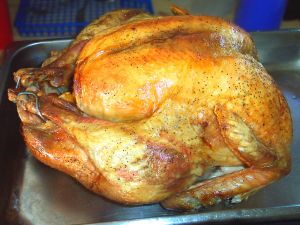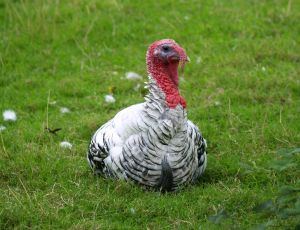 None of us wants to make our family and friends sick, and one of the major sources for stomachaches and feeling sick is food related. Food related illness is typically cause by contamination in the work area or improper food handling. When it comes to dealing with meat it’s even more important to take the steps to be sure your bird isn’t going to cause anyone to remember Thanksgiving for the terrible Turkey you served.
None of us wants to make our family and friends sick, and one of the major sources for stomachaches and feeling sick is food related. Food related illness is typically cause by contamination in the work area or improper food handling. When it comes to dealing with meat it’s even more important to take the steps to be sure your bird isn’t going to cause anyone to remember Thanksgiving for the terrible Turkey you served.
It doesn’t matter if you choose a fresh or frozen Turkey either has the potential to become a mouth-watering example of your culinary talents and bring on praise from even the most grumpy family member or guest. Every year thousands of people in the United States get sick because of improper handling of raw meat. Here are a few of the important steps a wise cook will take when getting their safe Turkey to the Thanksgiving table:
The most important part of safe cooking starts with a clean work space. Be sure to read the Blog, 3-Tips To Keep Your Kitchen Bacteria Claim Free While Cooking.
Now it’s time to talk about how to take care of your bird before it’s time to cook him:
 If you’re planning to cook a fresh Turkey be sure to keep it wrapped or covered, and refrigerated. It isn’t safe to stuff your turkey Wednesday night and then put it in the oven, the best advice is to stuff your bird just before you start to cook him.
If you’re planning to cook a fresh Turkey be sure to keep it wrapped or covered, and refrigerated. It isn’t safe to stuff your turkey Wednesday night and then put it in the oven, the best advice is to stuff your bird just before you start to cook him.
If you have a frozen turkey then on Tuesday, it’s time to properly thaw him by placing your frozen bird in a large container in the refrigerator. It should only take two days for most turkeys to thaw before cooking on Thursday.
![]() Meat shouldn’t ever be thawed on a counter. Air thaws food from the outside in, when bacteria grows on the outside it produces a toxic waste product, which isn’t destroyed through cooking.
Meat shouldn’t ever be thawed on a counter. Air thaws food from the outside in, when bacteria grows on the outside it produces a toxic waste product, which isn’t destroyed through cooking.
![]() Sometime very early on Thursday morning the alarm clocks of all Thanksgiving hosts and hostesses will ring loudly and we will jump from our beds, and rush to the kitchen to get our birds ready.
Sometime very early on Thursday morning the alarm clocks of all Thanksgiving hosts and hostesses will ring loudly and we will jump from our beds, and rush to the kitchen to get our birds ready.
- 1- My first step is to preheat the oven, and make a fresh disinfectant solution to wipe things down. You never know if the cat was on the counter hunting that mouse last night so, it’s important to re-sanitize your work space. Be sure to include the sink!
- 2-Your turkey should be very cold having been refrigerated properly, so it’s a great idea to be sure you have a hot-cup-of-something to drink while you work. Be sure to wash your hands very carefully, because the next step is getting your hands on the big-bird and cleaning the skin, removing the giblets, neck and other things typically packed inside.
- 3- I usually put the whole bird in my sink and clean him well. Always wash your bird with cold water and remove any stray feathers, or other parts you don’t want to cook. Then place the turkey someplace he can drip dry a little bit, I like to use a stainless-steel dish drainer in my sink and tilt the bird where the water runs out of any cavities.
- 4-While the bird drains, and dries it’s time put together any stuffing you plan to put inside your turkey. Ummm, this is when the house starts to smell like it’s going to be a very special fest day.
- 5-When the stuffing is ready, finish drying the Turkey, I usually use paper-towels and soak up any water or juices from the skin or inside the cavities–I like my stuffing on the dryer side and don’t want any excess moisture on the inside to make it soggy.
- 6-Then prepare the bird the way you like it. No matter how you choose to cook your bird the most important part is getting it to a safe internal temperature. The method you select is not as important is being sure your bird is cooked properly.
- 7-Cook your turkey properly in order to kill all bacteria and viruses. Stuffed or not the internal temperature should reach 165°F. A 12-lb turkey can easily handle 60 to 90 minutes of resting. During that time, temperature can rise 30 degrees if not exposed to drafts. A properly cooked turkey has juices that run clear and leg that move easily.
![]() Related Blogs:
Related Blogs:
- 3-Tips To Keep Your Kitchen Bacteria Claim Free While Cooking.
- How To Have a Claim Free Holiday Season
- Good Will for All–Guest Medical
Photo credit for this blog entry:  (no use restrictions for this photo)
(no use restrictions for this photo)
Glossary of Insurance Terms:
A | B | C | D | E | F | G | H | I | J-K | L | M | N | O | P | Q-R | S | T | U-V | W-Z
Families.com Blogs are for informational purposes only. Families.com assumes no responsibility for consumer choices. Consumers are reminded that it is their responsibility to research their choices properly and speak to a certified insurance professional prior to making any decision as important as an insurance purchase.

